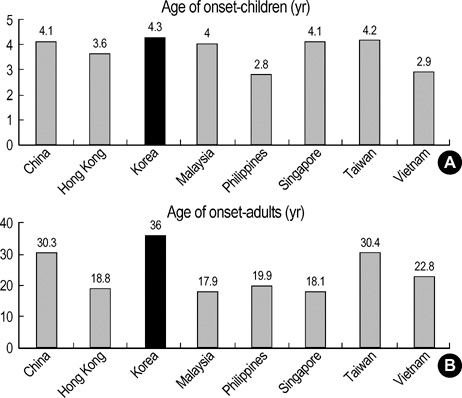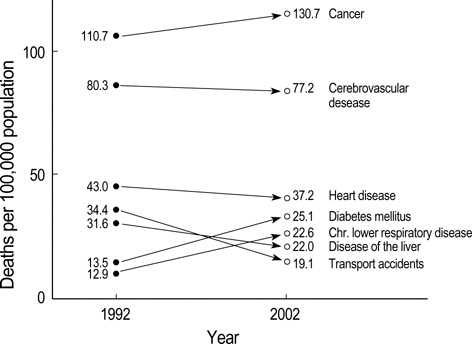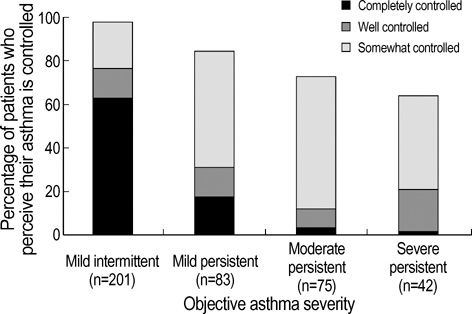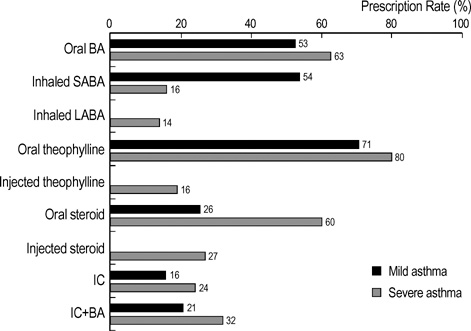The Current Status of Asthma in Korea
- Affiliations
-
- 1Department of Internal Medicine, Seoul National University College of Medicine, Seoul, Korea. shcho@plaza.snu.ac.kr
- 2Asia Pacific Epidemiology, GlaxoSmithKline Asia Pacific, Singapore.
- KMID: 1781819
- DOI: http://doi.org/10.3346/jkms.2006.21.2.181
Abstract
- A systematic review of English and Korean articles published between 1990 and 2004 and a search of database and various online resources was conducted to determine the prevalences, mortality rates, socioeconomic burden, quality of life, and treatment pattern of asthma in Korean adults and children. Asthma morbidity and mortality in Korea are steadily increasing. The prevalence of asthma in Korea is estimated to be 3.9% and its severity is often underestimated by both physicians and patients. Mortality resulting from chronic lower respiratory diseases including asthma increased from 12.9 to 22.6 deaths per 100,000 of the population between 1992 and 2002. Disease severity, level of control, and symptom state were all found to negatively impact the quality of life of asthmatics. Although international and Korean asthma management guidelines are available, familiarity with and implementation of these guidelines by primary care physicians remain poor.
Keyword
MeSH Terms
Figure
Cited by 9 articles
-
Correlation between the Korean Version of Asthma Control Test and Health-Related Quality of Life in Adult Asthmatics
Hyouk-Soo Kwon, So-Hee Lee, Min-Suk Yang, Sang-Min Lee, Sae-Hoon Kim, Deok-In Kim, Seong-Wook Sohn, Chang-Han Park, Heung-Woo Park, Sun-Sin Kim, Sang-Heon Cho, Kyung-Up Min, You-Young Kim, Yoon-Seok Chang
J Korean Med Sci. 2008;23(4):621-627. doi: 10.3346/jkms.2008.23.4.621.Customized Asthma Control Test with Reflection on Sociocultural Differences
Kwang-Ha Yoo, Jae-Won Jeong, Ho-Joo Yoon, Suk-Il Chang, Hee-Bom Moon, Byoung-Hwui Choi, You-Young Kim, Sang-Heon Cho
J Korean Med Sci. 2010;25(8):1134-1139. doi: 10.3346/jkms.2010.25.8.1134.A New Treatment Strategy for Asthma : SMART (Symbicort® Maintenance And Reliever Therapy)
Hae Sim Park, Young Min Ye
J Korean Med Assoc. 2007;50(3):279-283. doi: 10.5124/jkma.2007.50.3.279.Characteristics of depression and anxiety in elderly asthmatics
Eun Kyoung Park, Eun Jung Jo, Seung Eun Lee, Seung Geun Lee, Jeong Ha Mok, Mi Hyun Kim, Kwang Ha Lee, Ki Uk Kim, Doo Soo Jeon, Yun Seong Kim, Min Ki Lee, Hye-Kyung Park
Allergy Asthma Respir Dis. 2014;2(3):194-199. doi: 10.4168/aard.2014.2.3.194.Factors associated with mortality after asthma admission in the intensive care unit of a tertiary referral hospital
Sung-Shin Kwon, Min-Hye Kim, Young-Joo Cho
Allergy Asthma Respir Dis. 2015;3(6):432-438. doi: 10.4168/aard.2015.3.6.432.Implementation of Asthma Management Guidelines and Possible Barriers in Korea
Eun-Jung Jo, Mi-Yeong Kim, Sae-Hoon Kim, Yong-Eun Kwon, Hye-Kyung Park, Sang-Heon Cho, Yoon-Seok Chang
J Korean Med Sci. 2020;35(12):. doi: 10.3346/jkms.2020.35.e72.Increasing Prevalence and Mortality of Asthma With Age in Korea, 2002–2015: A Nationwide, Population-Based Study
Eunyoung Lee, Anhye Kim, Young-Min Ye, Sang-Eun Choi, Hae-Sim Park
Allergy Asthma Immunol Res. 2020;12(3):467-484. doi: 10.4168/aair.2020.12.3.467.Past, Present, and Future of Allergy in Korea
You-Young Kim
Allergy Asthma Immunol Res. 2010;2(3):155-164. doi: 10.4168/aair.2010.2.3.155.Immunopathogenesis of Allergic Asthma: More Than the Th2 Hypothesis
You-Me Kim, You-Sun Kim, Seong Gyu Jeon, Yoon-Keun Kim
Allergy Asthma Immunol Res. 2013;5(4):189-196. doi: 10.4168/aair.2013.5.4.189.
Reference
-
1. Sugita M, Kuribayashi K, Nakagomi T, Miyata S, Matsuyama T, Kitada O. Allergic bronchial asthma: airway inflammation and hyperresponsiveness. Intern Med. 2003. 42:636–643.
Article2. GINA Workshop Report. Global Strategy for Asthma Management and Prevention. accessed 7 Jan 2005. Available at: www.ginasthma.com.3. Upton MN, McConnachie A, McSharry C, Hart CL, Smith GD, Gillis CR, Watt GC. Intergenerational 20 year trends in the prevalence of asthma and hay fever in adults: the Midspan family study surveys of parents and offspring. BMJ. 2000. 321:88–92.
Article4. Ninan TK, Russell G. Respiratory symptoms and atopy in Aberdeen schoolchildren: evidences from two survey 25 years apart. BMJ. 1992. 304:873–875.5. Yunginger JW, Reed CE, O'Connell EJ, Melton LJ III, O'Fallon WM, Silverstein MD. A community-based study of the epidemiology of asthma. Incidence rates, 1964-1983. Am Rev Respir Dis. 1992. 146:888–894.
Article6. Lai CK, de Guia TS, Kim YY, Kuo SH, Mukhopadhyay A, Soriano JB, Trung PL, Zhong NS, Zainudin N, Zainudin BM. Asthma control in the Asia-Pacific region: The asthma insight and reality in Asia-Pacific study. J Allergy Clin Immunol. 2003. 111:263–268.7. Lee SI, Shin MH, Lee HB, Son BK, Koh YY, Kim KE, Ahn YO. Prevalence of symptoms of asthma and other allergic diseases in Korean children: a nationwide questionnaire survey. J Korean Med Sci. 2001. 16:155–164.8. Lee MH, Hong SC, Kim SH, Bahn JW, Kim TB, Kim YK, Cho SH, Min KU, Kim YY. Prevalence of asthma and atopy in children living in rural area of Cheju Island for an interval of three years. J Asthma Allergy Clin Immunol. 2002. 22:85–91.9. Kim YY, Cho SH, Kim WK, Park JK, Song SH, Kim YK, Jee YK, Ha MN, Ahn YO, Lee SI, Min KU. Prevalence of childhood asthma based on questionnaires and methacholine bronchial provocation test in Korea. Clin Exp Allergy. 1997. 27:761–768.
Article10. Lee JG, Moon HJ, Kim KS, Yoon JH, Kim SS, Park IY. Epidemiological study for allergic disease of school-aged children and adolescence in rural area of Korea. Korean J Otolaryngol-Head Neck Surg. 1998. 41:1156–1163.11. International Study of Asthma and Allergies in Childhood (ISAAC) Steering Committee. Worldwide variation in prevalence of symptoms of asthma, allergic rhinoconjunctivitis and atopic eczema: ISAAC. Lancet. 1998. 351:1225–1232.12. Isis Research/GlaxoSmithKline. Asthma Insights and Reality in Asia Pacific (AIRIAP) Korea: Executive Summary. 2002.13. Kim JJ, Kim SD, Meng KH, Ahn YO, Yum YT, Oh HC, Lee DB, Lee SI, Chun BY, Choi JS. Prevalence and disease experience rates in Korean physicians. J Korean Med Sci. 1998. 13:247–262.
Article14. Kim SH, Lee JY, Son SW, Jung JW, Kim YK, Cho SH, Min KU, Kim YY. Prevalence of adult asthma based on questionnaires and methacholine bronchial provocation test in Seoul. J Asthma Allergy Clin Immunol. 2001. 21:618–627.15. Kim YK, Kim SH, Tak YJ, Jee YK, Lee BJ, Kim SH, Park HW, Jung JW, Bahn JW, Chang YS, Choi DC, Chang SI, Min KU, Kim YY, Cho SH. High prevalence of current asthma and active smoking effect among the elderly. Clin Exp Allergy. 2002. 32:1706–1712.
Article16. Korea Institute for Health and Social Affairs (KIHASA). Prevalence of asthma like symptoms in Korean adult population. Korean J Med. 2001. 60:196–205.17. Son BK, Lim DH, Kim JH, Jun YH, Kim SK. Prevalence of allergic disease and asthma related conditions in primary school-aged children and comparison of pulmonary function test between normal and children with condition related with asthma. Pediatr Allergy Respir Dis. 1997. 7:198–206.18. International Study of Asthma and Allergies in Childhood (ISAAC) Steering Committee. Worldwide variations in the prevalence of asthma symptom: International Study of Asthma and Allergies in Childhood (ISAAC). Eur Respir J. 1998. 12:315–335.19. The World Factbook 2004 - Korea, South. Central Intelligence Agency. accessed: 15 Jan 2005. Available at: www.cia.gov/cia/publications/factbook/geos/ks.html.20. Weiss KB, Gergen PJ, Hodgson TA. An economic evaluation of asthma in the United States. N Engl J Med. 1992. 326:862–866.
Article21. Smith DH, Malone DC, Lawson KA, Okamoto LJ, Battista C, Saunders WB. A national estimate of the economic costs of asthma. Am J Respir Crit Care Med. 1997. 156:787–793.
Article22. Weiss KB, Sullivan SD, Lyttle CS. Trends in the cost of illness for asthma in the United States, 1985-1994. J Allergy Clin Immunol. 2000. 106:493–499.
Article23. Masoli M, Fabian D, Holt S, Beasley R. Global Initiative for Asthma (GINA) Program. The global burden of asthma: executive summary of the GINA Dissemination Committee report. Allergy. 2004. 59:469–478.
Article24. Enright PL, McClelland R, Newman AB, Gottlieb DJ, Lebowitz MD. Cardiovascular Health Study Research Group. Underdiagnosis and undertreatment of asthma in the elderly. Chest. 1999. 116:603–613.
Article25. Parameswaran K, Hildreth AJ, Chadha D, Keaney NP, Taylor IK, Bansal SK. Asthma in the elderly: underperceived, underdiagnosed, and undertreated: a community survey. Respir Med. 1998. 92:573–577.
Article26. Enlight PL. The diagnosis and management of asthma is much tougher in older patients. Curr Opin Allergy Clin Immunol. 2002. 2:175–181.27. Van Schayck CP, van Der Heijden FM, van Den Boom G, Tirimanna PR, van Herwaarden CL. Underdiagnosis of asthma: is the doctor or the patient to blame? The DIMCA project. Thorax. 2000. 55:562–565.
Article28. Kim OJ, Hoon CS. A clinical analysis on the patients of orient-medical therapies in emergency department. J Korean Soc Emerg Med. 1997. 8:553–558.29. Kang SD, Jeong JW, Moon BS, Kim JM. Current epidemiological status of cerebrovascular disease. J Korean Neurosurg Soc. 1999. 28:509–503.30. Cho HJ, Shim JY, Lee HR, Lee SH. Factors associated with possession of regular doctor in Korea. J Korean Acad Fam Med. 2001. 22:1612–1621.31. Choi H, Lim DH, Kim JH, Son BK, Lim JW. Study on the interrelationship of air pollution and respiratory diseases in Inchon City via children who visited the emergency room of Inha University Hospital. J Korean Pediatr Soc. 2000. 43:1372–1379.32. Kim KW, Choi IS, Park SC, Jang AS, Lim H. Risk factors of near-fatal asthma. Korean J Med. 1999. 57:52–59.33. Koh YY, Lee MH, Kim CK, Min YG, Kim YK, Min KU, Kim YY. A familial predisposition in bronchial hyperresponsiveness among patients with allergic rhinitis. J Allergy Clin Immunol. 1998. 102:921–926.
Article34. Jeong MG, Kim TS, Son BH, Kim SW. Clinical characteristics of hospitalized cases due to asthma attack combined with pneumonic infiltrates. Pediatr Allergy Respir Dis. 1999. 9:290–300.35. Yoon HS, Cha JK, Lee HR. A survey of current trends in the management of childhood asthma in practical fields. Pediatr Allergy Respir Dis. 1998. 8:167–178.36. Cheong HS, Park CS, Kim LH, Park BL, Uh ST, Kim YH, Lym GI, Lee JY, Lee JK, Kim HT, Ryu HJ, Han BG, Kim JW, Park C, Kimm K, Shin HD, Oh B. CXCR3 polymorphisms associated with risk of asthma. Biochem Biophys Res Commun. 2005. 334:1219–1225.
Article37. Park BL, Cheong HS, Kim LH, Choi YH, Namgoong S, Park HS, Hong SJ, Choi BW, Lee JH, Park CS, Shin HD. Association analysis of signal transducer and activator of transcription 4 (STAT4) polymorphisms with asthma. J Hum Genet. 2005. 50:133–138.
Article38. Lee JH, Park HS, Park SW, Jang AS, Uh ST, Rhim T, Park CS, Hong SJ, Holgate ST, Holloway JW, Shin HD. ADAM33 polymorphism: association with bronchial hyper-responsiveness in Korean asthmatics. Clin Exp Allergy. 2004. 34:860–865.
Article39. Shin HD, Park BL, Kim LH, Jung JH, Wang HJ, Kim YJ, Park HS, Hong SJ, Choi BW, Kim DJ, Park CS. Association of tumor necrosis factor polymorphisms with asthma and serum total IgE. Hum Mol Genet. 2004. 13:397–403.
Article40. Cho SH, Son JW, Koh YY, Min KU, Kim YY, Kim YK. Linkage between bronchial responsiveness to methacholine and gene markers of IL-4 cytokine gene cluster and T cell receptor alpha/delta gene complex in Korean nuclear families. Clin Exp Allergy. 2001. 31:103–109.41. Kim YK, Oh SY, Oh HB, Chun SY, Cho SH, Koh YY, Min KU, Kim YY. Coding single nucleotide polymorphism in the high-affinity immunoglobulin E receptor b chain (Fc epsilon RI-beta) gene is associated with immunoglobulin E receptor-mediated histamine release from basophile. Clin Exp Allergy. 2002. 32:751–755.42. Kim YK, Park HS, Kim HY, Jee YK, Son JW, Bae JM, Lee MH, Cho SH, Min KU, Kim YY. Citrus red mite (Panonychus citri) may be an important allergen in the development of asthma among exposed children. Clin Exp Allergy. 2001. 31:582–589.
Article43. Kim YK, Son JW, Kim HY, Park HS, Lee MH, Cho SH, Min KU, Kim YY. Citrus red mite (Panonychus citri) is the most common sensitizing allergen in citrus farmers with asthma and rhinitis. Clin Exp Allergy. 1999. 29:1102–1109.44. Kim YK, Lee MH, Jee YK, Hong SC, Bae JM, Chang YS, Jung JW, Lee BJ, Son JW, Cho SH, Min KU, Kim YY. Spider mite allergy in apple-cultivating farmers: European red mite (Panonychus ulmi) and two-spotted spider mite (Tetranychus urticae) may be important allergens in the development of work-related asthma and rhinitis symptoms. J Allergy Clin Immunol. 1999. 104:1285–1292.
Article45. Kang SK, Jee YK, Nahm DH, Min KU, Park JW, Park HS, Son CH, Cho SH, Choi I, Choi SW, Hong CS, Kim KS, Kim YY. A status of occupational asthma in Korea through the cases reported to the Occupational Asthma Surveillance Center. J Asthma Allergy Clin Immunol. 2000. 20:906–915.46. Ju YS, Cho SH. Effect of air pollution on emergency room visits for asthma: a time series analysis. Korean J Prev Med. 2001. 34:61–72.47. Lee JT, Kim H, Song H. Air pollution and asthma among children in Seoul, Korea. Epidemiology. 2002. 13:481–484.
Article48. Song HI. Effect of air pollution on childhood asthma living in Seoul. J Asthma Allergy Clin Immunol. 2001. 21:28–39.49. Park KA. Recent trends and patterns of mortality in Korea. Dev Soc. 1998. 27:67–81.50. News release: Summary report of the cause of death statistics in 2003. Korea National Statistical Office (KNSO). accessed: 3 Jan 2005. Available at: kosis.nso.go.kr/Magazine/YD/VD0002.xls.51. Mathers CD, SteiCn , Fat DM, Rao C, Inoue M, Tomijima N, Bernard C, Lopez AD, Murray CJL. Global programme on evidence for health policy discussion paper No. 50. Global burden of disease 2000: Version 2 methods and results. 2002. 10. World Health Organization.52. Kim JS, Wen Y. A comparative study on mortality patterns among Koreans, Korean-Chinese and Chinese. J Korean Med Sci. 1999. 14:365–372.
Article53. WHO mortality database. World Health Organization Statistical Information Service. accessed: 7 Jan 2005. Available at: www3.who.int/whosis/menu.cfm.54. Drug market statistics in 2004. Korea Pharmaceutical Manufactures Association. accessed: 23 Jan 2005. Available at: http://www.kpma.or.kr/kpma.55. Park JW, Cho YS, Lee SY, Nahm DH, Kim YK, Kim DK, Sohn JW, Park JK, Jee YK, Cho YJ, Yoon HJ, Kim MK, Park HS, Choi BW, Choi IS, Park CS, Min KU, Moon HB, Park SH, Lee YK, Kim NS, Hong CS. Multi-center study of the utilization of quality of life questionnaire for adult Korean asthmatics (QLQAKA). J Asthma Allergy Clin Immunol. 2000. 20:467–480.56. Rho HJ, Park MS, Park CW, Yun YY, Park JW, Hong CS, Suh JY, Kim DK. Factors influencing quality of life asthmatic patients in Korea. J Asthma Allergy Clin Immunol. 2000. 20:209–221.57. Kikuchi Y, Okabe S, Tamaura G, Hinda W, Homma M, Shirato K, Takishima T. Chemosensitivity and perception of dyspnea in patients with a history of near fatal asthma. N Engl J Med. 1994. 330:1329–1334.58. Fritz GK, McQuaid EL, Spirito A, Klein RB. Symptom perception in pediatric asthma: relationship to functional morbidity and psychological factors. J Am Acad Child Adolesc Psychiatry. 1996. 35:1033–1041.
Article59. Chetta A, Gerra G, Foresi A, Zaimovic A, Del Donno M, Chittoloni B, Malorgio R, Castagnaro A, Olivieri D. Personality profiles and breathlessness perception in outpatients with different gradings of asthma. Am J Respir Crit Care Med. 1998. 157:116–122.
Article60. Kim SG, Jang AS, Kim YK, Lee S, Seo JP, Yang SW, Choi SI, Park SH, Lee KR, Park JH. The effect of patient education on correct use of metered dose inhalers in patients with asthma. J Asthma Allergy Clin Immunol. 2000. 20:695–701.61. Lim JY, Chung SM, Choung JT. The role of patient and parents education in the management of pediatric asthma. Pediatr Allergy Respir Dis. 2000. 10:51–60.62. Korean Society of Allergology. National guideline for the management of asthma. J Asthma Allergy Clin Immunol. 1998. 18:338–390.63. Pyun BY. 2003 Guideline for the management of childhood asthma. Pediatr Allergy Respir Dis. 2003. 13:65–71.64. Guideline of chronic obstructive pulmonary disease (COPD) and asthma. Korean Academy of Tuberculosis and Respiratory Disease. accessed: 27 Dec 2004. Available at: www.lungkorea.com.65. Analysis of data from Health Insurance Review Agency (HIRA). Korea Institute for Health and Social Affairs (KIHASA). accessed: 16 Jan 2005. Available at: www.kihasa.re.kr/html/jsp/sub04_01.jsp.66. Rhee SE, Kim CH, Choi JY, Son MH, Kim KE, Lee KY. The study of home nebulizer use in asthmatic children. Pediatr Allergy Respir Dis. 2000. 10:141–152.67. Internet usage statistics. Internet statistics information system. accessed: 8 Jan 2005. Available at: isis.nic.or.kr/english.68. Peterson MW, Strommer-Pace L, Dayton C. Asthma patient education: current utilization in pulmonary training programs. J Asthma. 2001. 38:261–267.
Article69. Park HW, Min KU, Kim YY, Cho SH. Assessing the quality and contents of asthma-related information on the Korean internet as an educational material for patients. J Korean Med Sci. 2004. 19:364–368.
Article70. Song DJ, Kim HJ, Hong SH, Choung JT. Bronchial asthma education and the internet: The present situation and future direction. J Asthma Allergy Clin Immunol. 2004. 24:224–228.
- Full Text Links
- Actions
-
Cited
- CITED
-
- Close
- Share
- Similar articles
-
- Current Asthma Prevalence Using Methacholine Challenge Test in Korean Children from 2010 to 2014
- Age of asthma onset and its relevance to adult asthma in the general population
- The role of tiotropium in the management of asthma
- Association between Electronic Cigarettes Use and Asthma in the United States: Data from the National Health Interview Survey 2016–2019
- Evolution of Asthma Concept and Effect of Current Asthma Management Guidelines





